HND Business: Developing a Training Strategy for White & Whistle Ltd
VerifiedAdded on 2023/05/15
|9
|3971
|485
Case Study
AI Summary
This case study outlines a training and development strategy for White and Whistle Ltd, a call center focused on client satisfaction and employee well-being. The strategy emphasizes the benefits of training, including improved employee efficiency, reduced errors, leadership development, and enhanced teamwork. Key elements include alignment with organizational objectives, senior management support, involvement of call center managers, quality program design, participant motivation, and integration with human resource management policies. The strategy addresses organizational and individual training needs, considering strategic decisions such as training focus, development, location, provider, content, and evaluation methods. It highlights the importance of linking training initiatives to business requirements and using ROI models to make informed decisions. The goal is to enhance employee retention, reduce recruitment costs, and improve overall performance within the organization.

Assessment Title
Case Study
Qualification Module Code and title
HND in Business HA13 34
Continuous Workforce Development
Student ID Assessor’s Name
00006489 shenon paiva Mr. Milinda Mendis
Cohort Date Issued Submitted on
2nd Mar 2019
No. Learning Outcome Task no
1 Produce a training and development strategy for an organisation.
Learner Declaration
I certify that the work submitted for this Assessment is my own and research sources are fully
acknowledge.
Student Signature:………………………………… Date:………………..
White and Whistle Ltd
Training strategy for the year 2019 -2021
This study source was downloaded by 100000867073170 from CourseHero.com on 05-14-2023 02:30:03 GMT -05:00
https://www.coursehero.com/file/44577756/edited-White-and-Whistle-Ltddocx/
Case Study
Qualification Module Code and title
HND in Business HA13 34
Continuous Workforce Development
Student ID Assessor’s Name
00006489 shenon paiva Mr. Milinda Mendis
Cohort Date Issued Submitted on
2nd Mar 2019
No. Learning Outcome Task no
1 Produce a training and development strategy for an organisation.
Learner Declaration
I certify that the work submitted for this Assessment is my own and research sources are fully
acknowledge.
Student Signature:………………………………… Date:………………..
White and Whistle Ltd
Training strategy for the year 2019 -2021
This study source was downloaded by 100000867073170 from CourseHero.com on 05-14-2023 02:30:03 GMT -05:00
https://www.coursehero.com/file/44577756/edited-White-and-Whistle-Ltddocx/
Paraphrase This Document
Need a fresh take? Get an instant paraphrase of this document with our AI Paraphraser
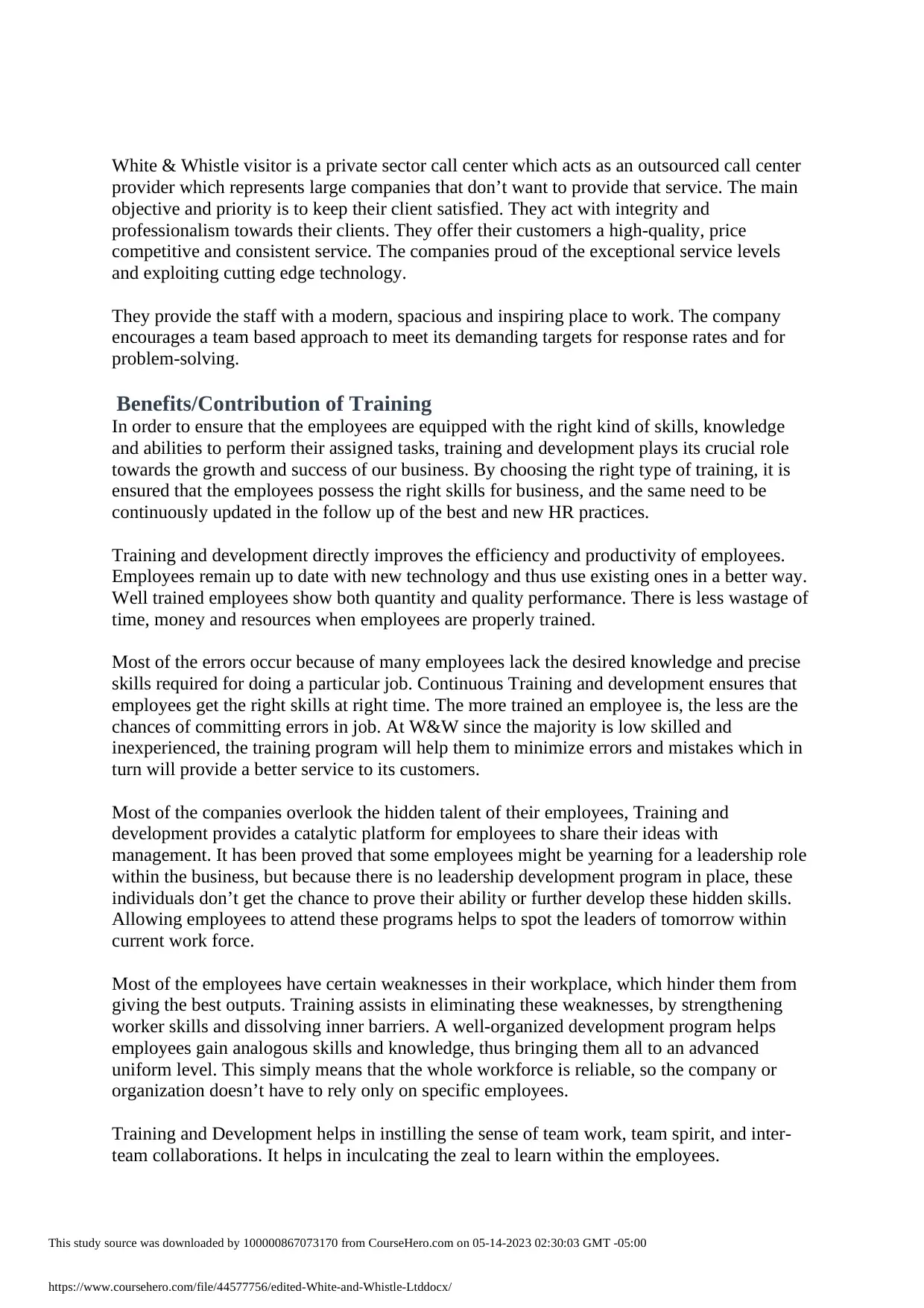
White & Whistle visitor is a private sector call center which acts as an outsourced call center
provider which represents large companies that don’t want to provide that service. The main
objective and priority is to keep their client satisfied. They act with integrity and
professionalism towards their clients. They offer their customers a high-quality, price
competitive and consistent service. The companies proud of the exceptional service levels
and exploiting cutting edge technology.
They provide the staff with a modern, spacious and inspiring place to work. The company
encourages a team based approach to meet its demanding targets for response rates and for
problem-solving.
Benefits/Contribution of Training
In order to ensure that the employees are equipped with the right kind of skills, knowledge
and abilities to perform their assigned tasks, training and development plays its crucial role
towards the growth and success of our business. By choosing the right type of training, it is
ensured that the employees possess the right skills for business, and the same need to be
continuously updated in the follow up of the best and new HR practices.
Training and development directly improves the efficiency and productivity of employees.
Employees remain up to date with new technology and thus use existing ones in a better way.
Well trained employees show both quantity and quality performance. There is less wastage of
time, money and resources when employees are properly trained.
Most of the errors occur because of many employees lack the desired knowledge and precise
skills required for doing a particular job. Continuous Training and development ensures that
employees get the right skills at right time. The more trained an employee is, the less are the
chances of committing errors in job. At W&W since the majority is low skilled and
inexperienced, the training program will help them to minimize errors and mistakes which in
turn will provide a better service to its customers.
Most of the companies overlook the hidden talent of their employees, Training and
development provides a catalytic platform for employees to share their ideas with
management. It has been proved that some employees might be yearning for a leadership role
within the business, but because there is no leadership development program in place, these
individuals don’t get the chance to prove their ability or further develop these hidden skills.
Allowing employees to attend these programs helps to spot the leaders of tomorrow within
current work force.
Most of the employees have certain weaknesses in their workplace, which hinder them from
giving the best outputs. Training assists in eliminating these weaknesses, by strengthening
worker skills and dissolving inner barriers. A well-organized development program helps
employees gain analogous skills and knowledge, thus bringing them all to an advanced
uniform level. This simply means that the whole workforce is reliable, so the company or
organization doesn’t have to rely only on specific employees.
Training and Development helps in instilling the sense of team work, team spirit, and inter-
team collaborations. It helps in inculcating the zeal to learn within the employees.
This study source was downloaded by 100000867073170 from CourseHero.com on 05-14-2023 02:30:03 GMT -05:00
https://www.coursehero.com/file/44577756/edited-White-and-Whistle-Ltddocx/
provider which represents large companies that don’t want to provide that service. The main
objective and priority is to keep their client satisfied. They act with integrity and
professionalism towards their clients. They offer their customers a high-quality, price
competitive and consistent service. The companies proud of the exceptional service levels
and exploiting cutting edge technology.
They provide the staff with a modern, spacious and inspiring place to work. The company
encourages a team based approach to meet its demanding targets for response rates and for
problem-solving.
Benefits/Contribution of Training
In order to ensure that the employees are equipped with the right kind of skills, knowledge
and abilities to perform their assigned tasks, training and development plays its crucial role
towards the growth and success of our business. By choosing the right type of training, it is
ensured that the employees possess the right skills for business, and the same need to be
continuously updated in the follow up of the best and new HR practices.
Training and development directly improves the efficiency and productivity of employees.
Employees remain up to date with new technology and thus use existing ones in a better way.
Well trained employees show both quantity and quality performance. There is less wastage of
time, money and resources when employees are properly trained.
Most of the errors occur because of many employees lack the desired knowledge and precise
skills required for doing a particular job. Continuous Training and development ensures that
employees get the right skills at right time. The more trained an employee is, the less are the
chances of committing errors in job. At W&W since the majority is low skilled and
inexperienced, the training program will help them to minimize errors and mistakes which in
turn will provide a better service to its customers.
Most of the companies overlook the hidden talent of their employees, Training and
development provides a catalytic platform for employees to share their ideas with
management. It has been proved that some employees might be yearning for a leadership role
within the business, but because there is no leadership development program in place, these
individuals don’t get the chance to prove their ability or further develop these hidden skills.
Allowing employees to attend these programs helps to spot the leaders of tomorrow within
current work force.
Most of the employees have certain weaknesses in their workplace, which hinder them from
giving the best outputs. Training assists in eliminating these weaknesses, by strengthening
worker skills and dissolving inner barriers. A well-organized development program helps
employees gain analogous skills and knowledge, thus bringing them all to an advanced
uniform level. This simply means that the whole workforce is reliable, so the company or
organization doesn’t have to rely only on specific employees.
Training and Development helps in instilling the sense of team work, team spirit, and inter-
team collaborations. It helps in inculcating the zeal to learn within the employees.
This study source was downloaded by 100000867073170 from CourseHero.com on 05-14-2023 02:30:03 GMT -05:00
https://www.coursehero.com/file/44577756/edited-White-and-Whistle-Ltddocx/
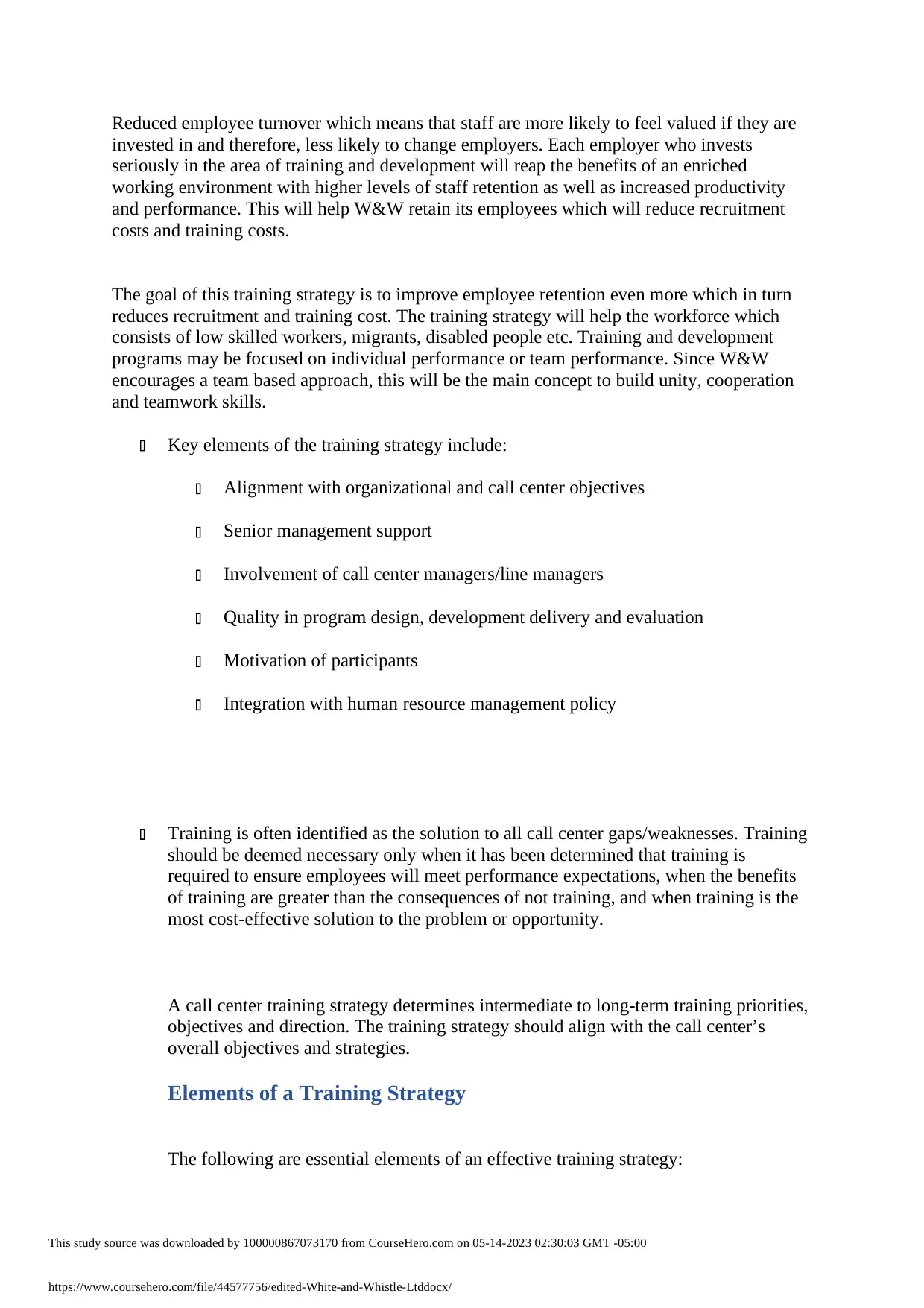
Reduced employee turnover which means that staff are more likely to feel valued if they are
invested in and therefore, less likely to change employers. Each employer who invests
seriously in the area of training and development will reap the benefits of an enriched
working environment with higher levels of staff retention as well as increased productivity
and performance. This will help W&W retain its employees which will reduce recruitment
costs and training costs.
The goal of this training strategy is to improve employee retention even more which in turn
reduces recruitment and training cost. The training strategy will help the workforce which
consists of low skilled workers, migrants, disabled people etc. Training and development
programs may be focused on individual performance or team performance. Since W&W
encourages a team based approach, this will be the main concept to build unity, cooperation
and teamwork skills.
Key elements of the training strategy include:
Alignment with organizational and call center objectives
Senior management support
Involvement of call center managers/line managers
Quality in program design, development delivery and evaluation
Motivation of participants
Integration with human resource management policy
Training is often identified as the solution to all call center gaps/weaknesses. Training
should be deemed necessary only when it has been determined that training is
required to ensure employees will meet performance expectations, when the benefits
of training are greater than the consequences of not training, and when training is the
most cost-effective solution to the problem or opportunity.
A call center training strategy determines intermediate to long-term training priorities,
objectives and direction. The training strategy should align with the call center’s
overall objectives and strategies.
Elements of a Training Strategy
The following are essential elements of an effective training strategy:
This study source was downloaded by 100000867073170 from CourseHero.com on 05-14-2023 02:30:03 GMT -05:00
https://www.coursehero.com/file/44577756/edited-White-and-Whistle-Ltddocx/
invested in and therefore, less likely to change employers. Each employer who invests
seriously in the area of training and development will reap the benefits of an enriched
working environment with higher levels of staff retention as well as increased productivity
and performance. This will help W&W retain its employees which will reduce recruitment
costs and training costs.
The goal of this training strategy is to improve employee retention even more which in turn
reduces recruitment and training cost. The training strategy will help the workforce which
consists of low skilled workers, migrants, disabled people etc. Training and development
programs may be focused on individual performance or team performance. Since W&W
encourages a team based approach, this will be the main concept to build unity, cooperation
and teamwork skills.
Key elements of the training strategy include:
Alignment with organizational and call center objectives
Senior management support
Involvement of call center managers/line managers
Quality in program design, development delivery and evaluation
Motivation of participants
Integration with human resource management policy
Training is often identified as the solution to all call center gaps/weaknesses. Training
should be deemed necessary only when it has been determined that training is
required to ensure employees will meet performance expectations, when the benefits
of training are greater than the consequences of not training, and when training is the
most cost-effective solution to the problem or opportunity.
A call center training strategy determines intermediate to long-term training priorities,
objectives and direction. The training strategy should align with the call center’s
overall objectives and strategies.
Elements of a Training Strategy
The following are essential elements of an effective training strategy:
This study source was downloaded by 100000867073170 from CourseHero.com on 05-14-2023 02:30:03 GMT -05:00
https://www.coursehero.com/file/44577756/edited-White-and-Whistle-Ltddocx/
⊘ This is a preview!⊘
Do you want full access?
Subscribe today to unlock all pages.

Trusted by 1+ million students worldwide
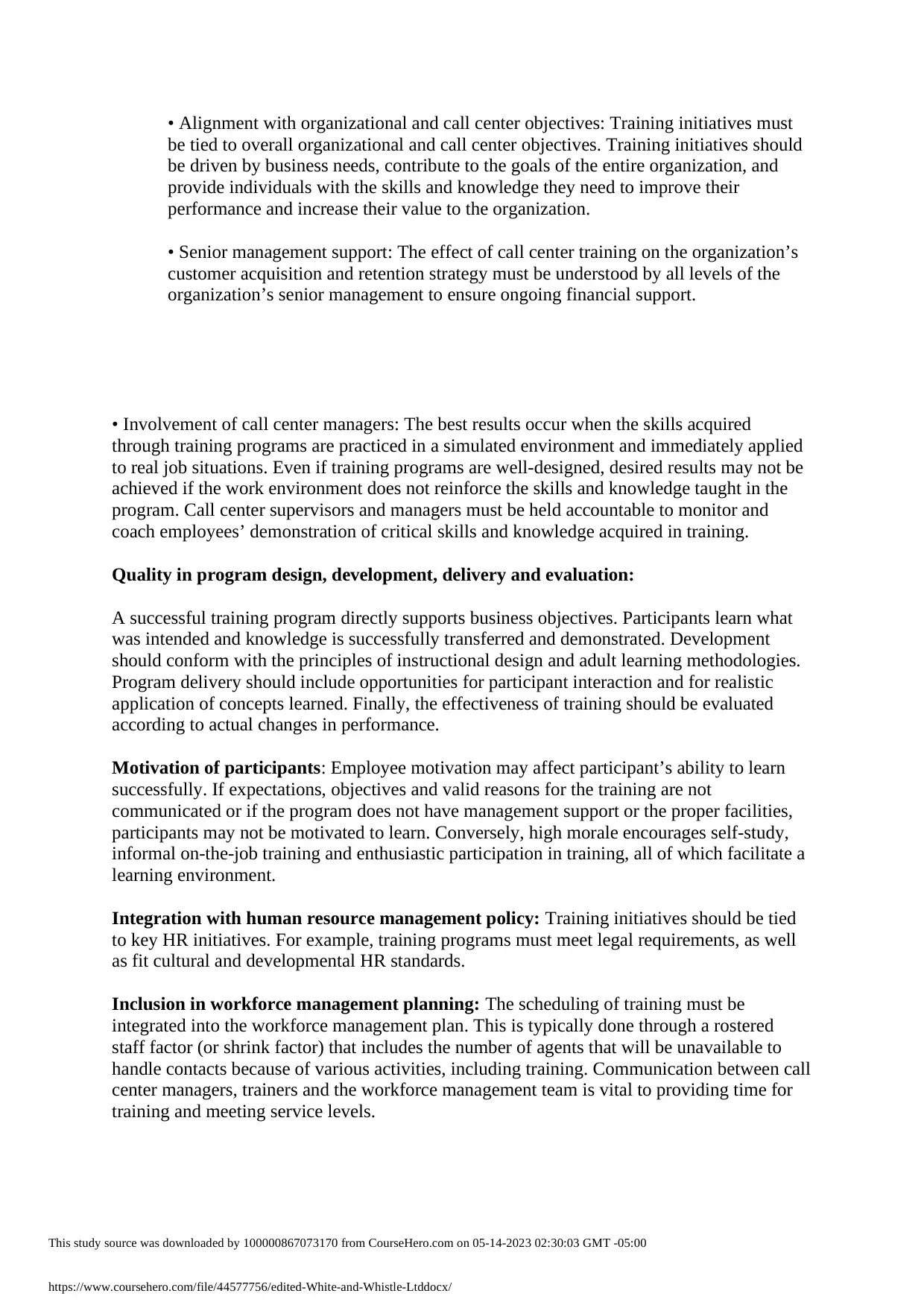
• Alignment with organizational and call center objectives: Training initiatives must
be tied to overall organizational and call center objectives. Training initiatives should
be driven by business needs, contribute to the goals of the entire organization, and
provide individuals with the skills and knowledge they need to improve their
performance and increase their value to the organization.
• Senior management support: The effect of call center training on the organization’s
customer acquisition and retention strategy must be understood by all levels of the
organization’s senior management to ensure ongoing financial support.
• Involvement of call center managers: The best results occur when the skills acquired
through training programs are practiced in a simulated environment and immediately applied
to real job situations. Even if training programs are well-designed, desired results may not be
achieved if the work environment does not reinforce the skills and knowledge taught in the
program. Call center supervisors and managers must be held accountable to monitor and
coach employees’ demonstration of critical skills and knowledge acquired in training.
Quality in program design, development, delivery and evaluation:
A successful training program directly supports business objectives. Participants learn what
was intended and knowledge is successfully transferred and demonstrated. Development
should conform with the principles of instructional design and adult learning methodologies.
Program delivery should include opportunities for participant interaction and for realistic
application of concepts learned. Finally, the effectiveness of training should be evaluated
according to actual changes in performance.
Motivation of participants: Employee motivation may affect participant’s ability to learn
successfully. If expectations, objectives and valid reasons for the training are not
communicated or if the program does not have management support or the proper facilities,
participants may not be motivated to learn. Conversely, high morale encourages self-study,
informal on-the-job training and enthusiastic participation in training, all of which facilitate a
learning environment.
Integration with human resource management policy: Training initiatives should be tied
to key HR initiatives. For example, training programs must meet legal requirements, as well
as fit cultural and developmental HR standards.
Inclusion in workforce management planning: The scheduling of training must be
integrated into the workforce management plan. This is typically done through a rostered
staff factor (or shrink factor) that includes the number of agents that will be unavailable to
handle contacts because of various activities, including training. Communication between call
center managers, trainers and the workforce management team is vital to providing time for
training and meeting service levels.
This study source was downloaded by 100000867073170 from CourseHero.com on 05-14-2023 02:30:03 GMT -05:00
https://www.coursehero.com/file/44577756/edited-White-and-Whistle-Ltddocx/
be tied to overall organizational and call center objectives. Training initiatives should
be driven by business needs, contribute to the goals of the entire organization, and
provide individuals with the skills and knowledge they need to improve their
performance and increase their value to the organization.
• Senior management support: The effect of call center training on the organization’s
customer acquisition and retention strategy must be understood by all levels of the
organization’s senior management to ensure ongoing financial support.
• Involvement of call center managers: The best results occur when the skills acquired
through training programs are practiced in a simulated environment and immediately applied
to real job situations. Even if training programs are well-designed, desired results may not be
achieved if the work environment does not reinforce the skills and knowledge taught in the
program. Call center supervisors and managers must be held accountable to monitor and
coach employees’ demonstration of critical skills and knowledge acquired in training.
Quality in program design, development, delivery and evaluation:
A successful training program directly supports business objectives. Participants learn what
was intended and knowledge is successfully transferred and demonstrated. Development
should conform with the principles of instructional design and adult learning methodologies.
Program delivery should include opportunities for participant interaction and for realistic
application of concepts learned. Finally, the effectiveness of training should be evaluated
according to actual changes in performance.
Motivation of participants: Employee motivation may affect participant’s ability to learn
successfully. If expectations, objectives and valid reasons for the training are not
communicated or if the program does not have management support or the proper facilities,
participants may not be motivated to learn. Conversely, high morale encourages self-study,
informal on-the-job training and enthusiastic participation in training, all of which facilitate a
learning environment.
Integration with human resource management policy: Training initiatives should be tied
to key HR initiatives. For example, training programs must meet legal requirements, as well
as fit cultural and developmental HR standards.
Inclusion in workforce management planning: The scheduling of training must be
integrated into the workforce management plan. This is typically done through a rostered
staff factor (or shrink factor) that includes the number of agents that will be unavailable to
handle contacts because of various activities, including training. Communication between call
center managers, trainers and the workforce management team is vital to providing time for
training and meeting service levels.
This study source was downloaded by 100000867073170 from CourseHero.com on 05-14-2023 02:30:03 GMT -05:00
https://www.coursehero.com/file/44577756/edited-White-and-Whistle-Ltddocx/
Paraphrase This Document
Need a fresh take? Get an instant paraphrase of this document with our AI Paraphraser
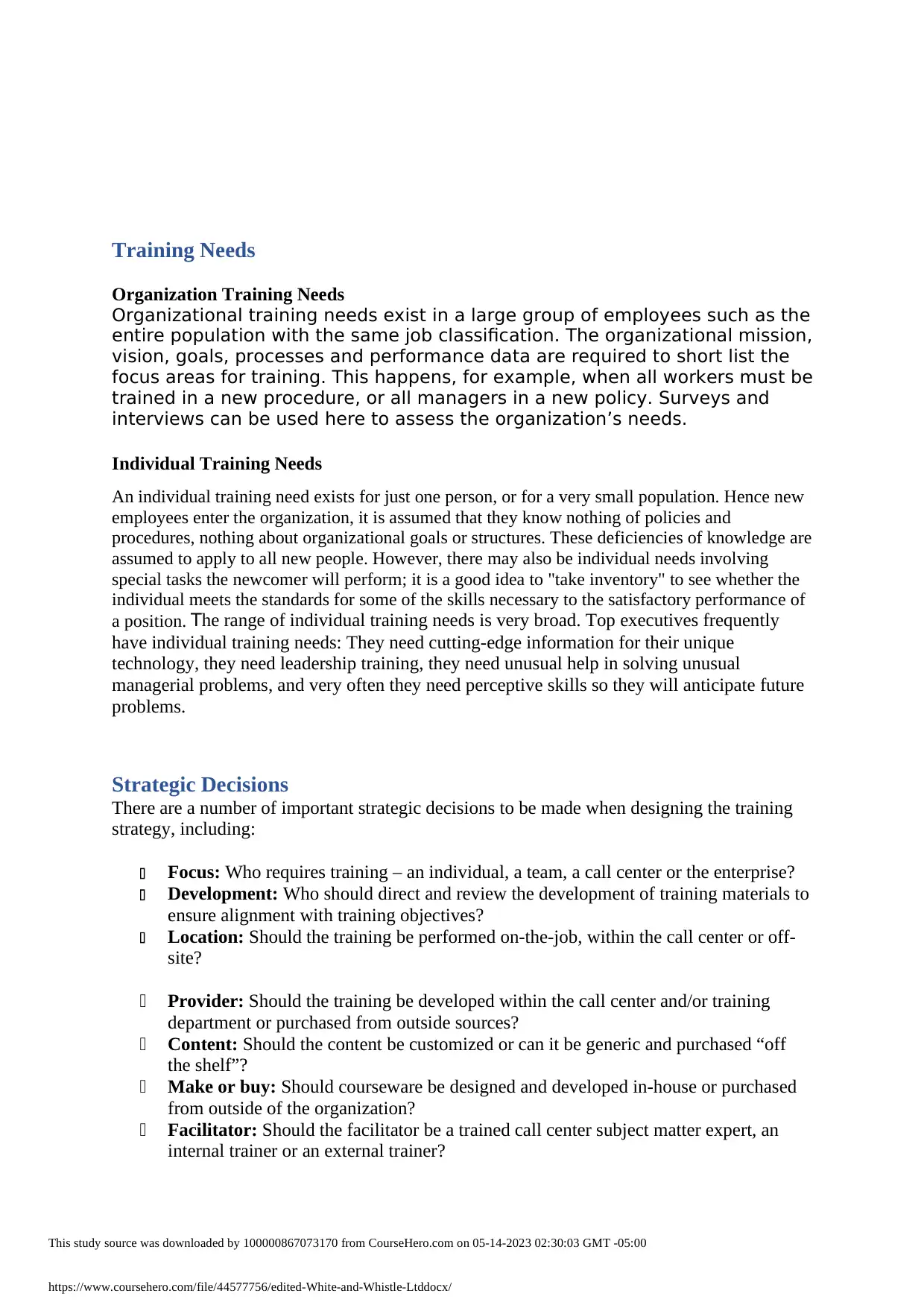
Training Needs
Organization Training Needs
Organizational training needs exist in a large group of employees such as the
entire population with the same job classification. The organizational mission,
vision, goals, processes and performance data are required to short list the
focus areas for training. This happens, for example, when all workers must be
trained in a new procedure, or all managers in a new policy. Surveys and
interviews can be used here to assess the organization’s needs.
Individual Training Needs
An individual training need exists for just one person, or for a very small population. Hence new
employees enter the organization, it is assumed that they know nothing of policies and
procedures, nothing about organizational goals or structures. These deficiencies of knowledge are
assumed to apply to all new people. However, there may also be individual needs involving
special tasks the newcomer will perform; it is a good idea to "take inventory" to see whether the
individual meets the standards for some of the skills necessary to the satisfactory performance of
a position. The range of individual training needs is very broad. Top executives frequently
have individual training needs: They need cutting-edge information for their unique
technology, they need leadership training, they need unusual help in solving unusual
managerial problems, and very often they need perceptive skills so they will anticipate future
problems.
Strategic Decisions
There are a number of important strategic decisions to be made when designing the training
strategy, including:
Focus: Who requires training – an individual, a team, a call center or the enterprise?
Development: Who should direct and review the development of training materials to
ensure alignment with training objectives?
Location: Should the training be performed on-the-job, within the call center or off-
site?
Provider: Should the training be developed within the call center and/or training
department or purchased from outside sources?
Content: Should the content be customized or can it be generic and purchased “off
the shelf”?
Make or buy: Should courseware be designed and developed in-house or purchased
from outside of the organization?
Facilitator: Should the facilitator be a trained call center subject matter expert, an
internal trainer or an external trainer?
This study source was downloaded by 100000867073170 from CourseHero.com on 05-14-2023 02:30:03 GMT -05:00
https://www.coursehero.com/file/44577756/edited-White-and-Whistle-Ltddocx/
Organization Training Needs
Organizational training needs exist in a large group of employees such as the
entire population with the same job classification. The organizational mission,
vision, goals, processes and performance data are required to short list the
focus areas for training. This happens, for example, when all workers must be
trained in a new procedure, or all managers in a new policy. Surveys and
interviews can be used here to assess the organization’s needs.
Individual Training Needs
An individual training need exists for just one person, or for a very small population. Hence new
employees enter the organization, it is assumed that they know nothing of policies and
procedures, nothing about organizational goals or structures. These deficiencies of knowledge are
assumed to apply to all new people. However, there may also be individual needs involving
special tasks the newcomer will perform; it is a good idea to "take inventory" to see whether the
individual meets the standards for some of the skills necessary to the satisfactory performance of
a position. The range of individual training needs is very broad. Top executives frequently
have individual training needs: They need cutting-edge information for their unique
technology, they need leadership training, they need unusual help in solving unusual
managerial problems, and very often they need perceptive skills so they will anticipate future
problems.
Strategic Decisions
There are a number of important strategic decisions to be made when designing the training
strategy, including:
Focus: Who requires training – an individual, a team, a call center or the enterprise?
Development: Who should direct and review the development of training materials to
ensure alignment with training objectives?
Location: Should the training be performed on-the-job, within the call center or off-
site?
Provider: Should the training be developed within the call center and/or training
department or purchased from outside sources?
Content: Should the content be customized or can it be generic and purchased “off
the shelf”?
Make or buy: Should courseware be designed and developed in-house or purchased
from outside of the organization?
Facilitator: Should the facilitator be a trained call center subject matter expert, an
internal trainer or an external trainer?
This study source was downloaded by 100000867073170 from CourseHero.com on 05-14-2023 02:30:03 GMT -05:00
https://www.coursehero.com/file/44577756/edited-White-and-Whistle-Ltddocx/
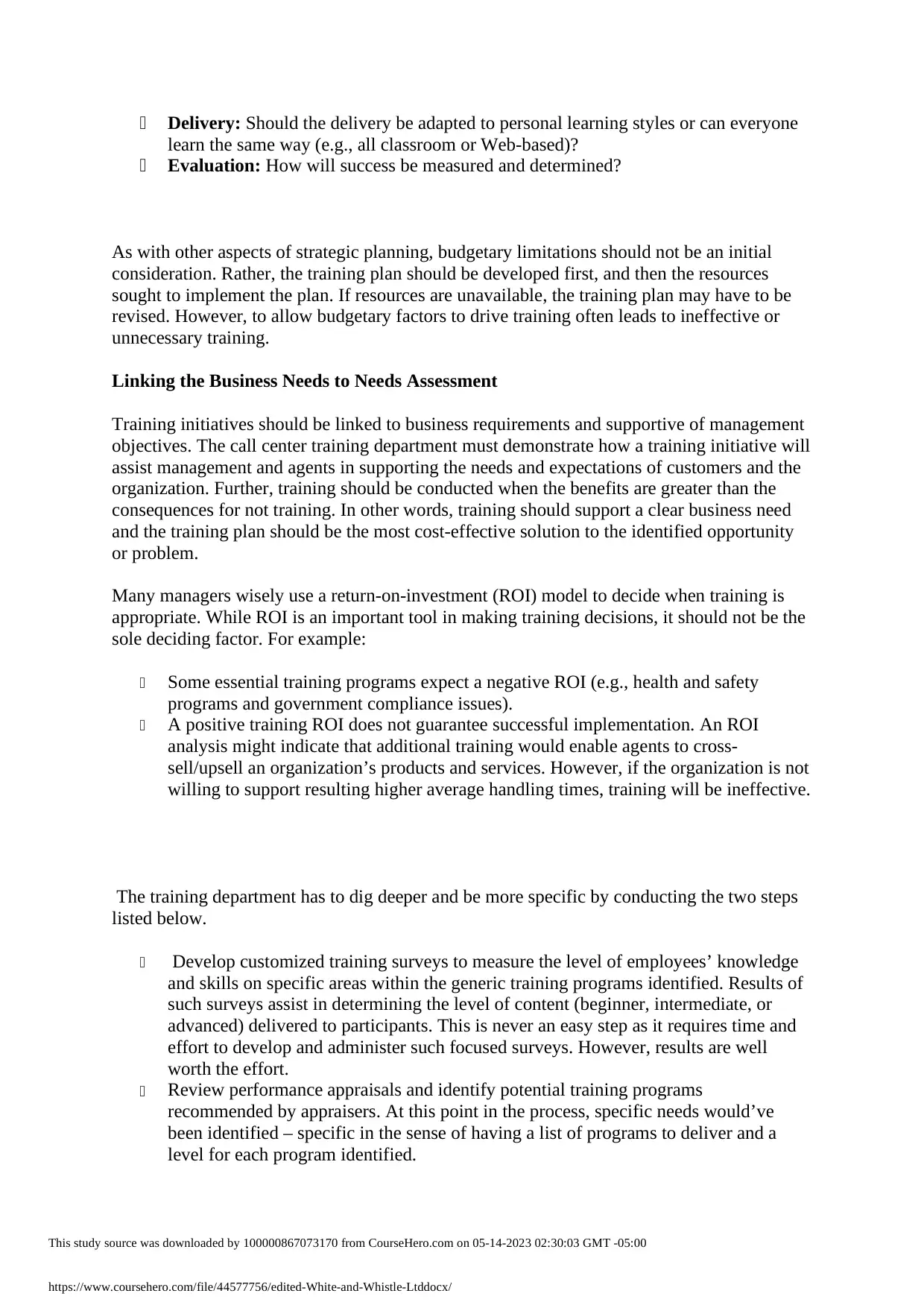
Delivery: Should the delivery be adapted to personal learning styles or can everyone
learn the same way (e.g., all classroom or Web-based)?
Evaluation: How will success be measured and determined?
As with other aspects of strategic planning, budgetary limitations should not be an initial
consideration. Rather, the training plan should be developed first, and then the resources
sought to implement the plan. If resources are unavailable, the training plan may have to be
revised. However, to allow budgetary factors to drive training often leads to ineffective or
unnecessary training.
Linking the Business Needs to Needs Assessment
Training initiatives should be linked to business requirements and supportive of management
objectives. The call center training department must demonstrate how a training initiative will
assist management and agents in supporting the needs and expectations of customers and the
organization. Further, training should be conducted when the benefits are greater than the
consequences for not training. In other words, training should support a clear business need
and the training plan should be the most cost-effective solution to the identified opportunity
or problem.
Many managers wisely use a return-on-investment (ROI) model to decide when training is
appropriate. While ROI is an important tool in making training decisions, it should not be the
sole deciding factor. For example:
Some essential training programs expect a negative ROI (e.g., health and safety
programs and government compliance issues).
A positive training ROI does not guarantee successful implementation. An ROI
analysis might indicate that additional training would enable agents to cross-
sell/upsell an organization’s products and services. However, if the organization is not
willing to support resulting higher average handling times, training will be ineffective.
The training department has to dig deeper and be more specific by conducting the two steps
listed below.
Develop customized training surveys to measure the level of employees’ knowledge
and skills on specific areas within the generic training programs identified. Results of
such surveys assist in determining the level of content (beginner, intermediate, or
advanced) delivered to participants. This is never an easy step as it requires time and
effort to develop and administer such focused surveys. However, results are well
worth the effort.
Review performance appraisals and identify potential training programs
recommended by appraisers. At this point in the process, specific needs would’ve
been identified – specific in the sense of having a list of programs to deliver and a
level for each program identified.
This study source was downloaded by 100000867073170 from CourseHero.com on 05-14-2023 02:30:03 GMT -05:00
https://www.coursehero.com/file/44577756/edited-White-and-Whistle-Ltddocx/
learn the same way (e.g., all classroom or Web-based)?
Evaluation: How will success be measured and determined?
As with other aspects of strategic planning, budgetary limitations should not be an initial
consideration. Rather, the training plan should be developed first, and then the resources
sought to implement the plan. If resources are unavailable, the training plan may have to be
revised. However, to allow budgetary factors to drive training often leads to ineffective or
unnecessary training.
Linking the Business Needs to Needs Assessment
Training initiatives should be linked to business requirements and supportive of management
objectives. The call center training department must demonstrate how a training initiative will
assist management and agents in supporting the needs and expectations of customers and the
organization. Further, training should be conducted when the benefits are greater than the
consequences for not training. In other words, training should support a clear business need
and the training plan should be the most cost-effective solution to the identified opportunity
or problem.
Many managers wisely use a return-on-investment (ROI) model to decide when training is
appropriate. While ROI is an important tool in making training decisions, it should not be the
sole deciding factor. For example:
Some essential training programs expect a negative ROI (e.g., health and safety
programs and government compliance issues).
A positive training ROI does not guarantee successful implementation. An ROI
analysis might indicate that additional training would enable agents to cross-
sell/upsell an organization’s products and services. However, if the organization is not
willing to support resulting higher average handling times, training will be ineffective.
The training department has to dig deeper and be more specific by conducting the two steps
listed below.
Develop customized training surveys to measure the level of employees’ knowledge
and skills on specific areas within the generic training programs identified. Results of
such surveys assist in determining the level of content (beginner, intermediate, or
advanced) delivered to participants. This is never an easy step as it requires time and
effort to develop and administer such focused surveys. However, results are well
worth the effort.
Review performance appraisals and identify potential training programs
recommended by appraisers. At this point in the process, specific needs would’ve
been identified – specific in the sense of having a list of programs to deliver and a
level for each program identified.
This study source was downloaded by 100000867073170 from CourseHero.com on 05-14-2023 02:30:03 GMT -05:00
https://www.coursehero.com/file/44577756/edited-White-and-Whistle-Ltddocx/
⊘ This is a preview!⊘
Do you want full access?
Subscribe today to unlock all pages.

Trusted by 1+ million students worldwide
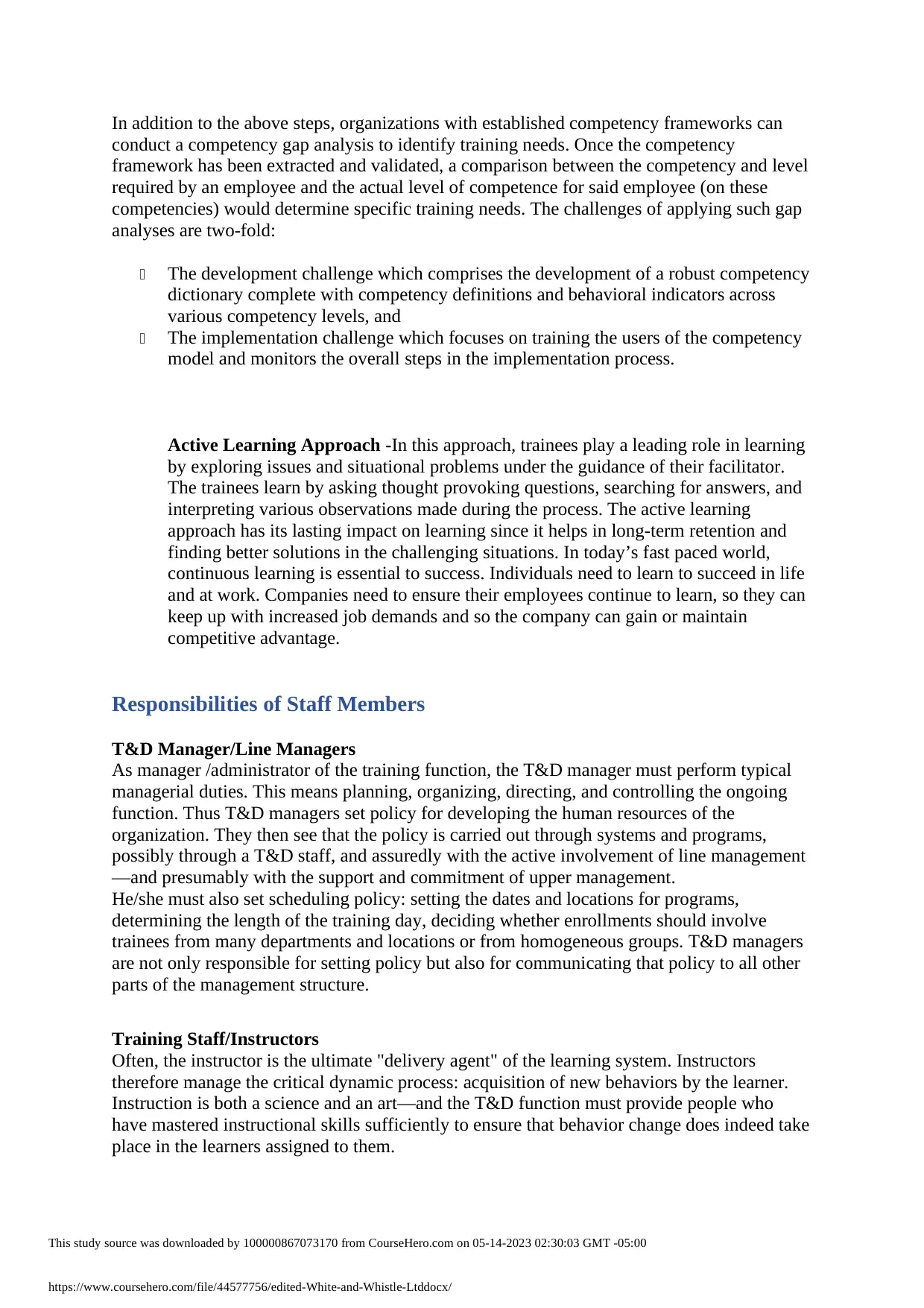
In addition to the above steps, organizations with established competency frameworks can
conduct a competency gap analysis to identify training needs. Once the competency
framework has been extracted and validated, a comparison between the competency and level
required by an employee and the actual level of competence for said employee (on these
competencies) would determine specific training needs. The challenges of applying such gap
analyses are two-fold:
The development challenge which comprises the development of a robust competency
dictionary complete with competency definitions and behavioral indicators across
various competency levels, and
The implementation challenge which focuses on training the users of the competency
model and monitors the overall steps in the implementation process.
Active Learning Approach -In this approach, trainees play a leading role in learning
by exploring issues and situational problems under the guidance of their facilitator.
The trainees learn by asking thought provoking questions, searching for answers, and
interpreting various observations made during the process. The active learning
approach has its lasting impact on learning since it helps in long-term retention and
finding better solutions in the challenging situations. In today’s fast paced world,
continuous learning is essential to success. Individuals need to learn to succeed in life
and at work. Companies need to ensure their employees continue to learn, so they can
keep up with increased job demands and so the company can gain or maintain
competitive advantage.
Responsibilities of Staff Members
T&D Manager/Line Managers
As manager /administrator of the training function, the T&D manager must perform typical
managerial duties. This means planning, organizing, directing, and controlling the ongoing
function. Thus T&D managers set policy for developing the human resources of the
organization. They then see that the policy is carried out through systems and programs,
possibly through a T&D staff, and assuredly with the active involvement of line management
—and presumably with the support and commitment of upper management.
He/she must also set scheduling policy: setting the dates and locations for programs,
determining the length of the training day, deciding whether enrollments should involve
trainees from many departments and locations or from homogeneous groups. T&D managers
are not only responsible for setting policy but also for communicating that policy to all other
parts of the management structure.
Training Staff/Instructors
Often, the instructor is the ultimate "delivery agent" of the learning system. Instructors
therefore manage the critical dynamic process: acquisition of new behaviors by the learner.
Instruction is both a science and an art—and the T&D function must provide people who
have mastered instructional skills sufficiently to ensure that behavior change does indeed take
place in the learners assigned to them.
This study source was downloaded by 100000867073170 from CourseHero.com on 05-14-2023 02:30:03 GMT -05:00
https://www.coursehero.com/file/44577756/edited-White-and-Whistle-Ltddocx/
conduct a competency gap analysis to identify training needs. Once the competency
framework has been extracted and validated, a comparison between the competency and level
required by an employee and the actual level of competence for said employee (on these
competencies) would determine specific training needs. The challenges of applying such gap
analyses are two-fold:
The development challenge which comprises the development of a robust competency
dictionary complete with competency definitions and behavioral indicators across
various competency levels, and
The implementation challenge which focuses on training the users of the competency
model and monitors the overall steps in the implementation process.
Active Learning Approach -In this approach, trainees play a leading role in learning
by exploring issues and situational problems under the guidance of their facilitator.
The trainees learn by asking thought provoking questions, searching for answers, and
interpreting various observations made during the process. The active learning
approach has its lasting impact on learning since it helps in long-term retention and
finding better solutions in the challenging situations. In today’s fast paced world,
continuous learning is essential to success. Individuals need to learn to succeed in life
and at work. Companies need to ensure their employees continue to learn, so they can
keep up with increased job demands and so the company can gain or maintain
competitive advantage.
Responsibilities of Staff Members
T&D Manager/Line Managers
As manager /administrator of the training function, the T&D manager must perform typical
managerial duties. This means planning, organizing, directing, and controlling the ongoing
function. Thus T&D managers set policy for developing the human resources of the
organization. They then see that the policy is carried out through systems and programs,
possibly through a T&D staff, and assuredly with the active involvement of line management
—and presumably with the support and commitment of upper management.
He/she must also set scheduling policy: setting the dates and locations for programs,
determining the length of the training day, deciding whether enrollments should involve
trainees from many departments and locations or from homogeneous groups. T&D managers
are not only responsible for setting policy but also for communicating that policy to all other
parts of the management structure.
Training Staff/Instructors
Often, the instructor is the ultimate "delivery agent" of the learning system. Instructors
therefore manage the critical dynamic process: acquisition of new behaviors by the learner.
Instruction is both a science and an art—and the T&D function must provide people who
have mastered instructional skills sufficiently to ensure that behavior change does indeed take
place in the learners assigned to them.
This study source was downloaded by 100000867073170 from CourseHero.com on 05-14-2023 02:30:03 GMT -05:00
https://www.coursehero.com/file/44577756/edited-White-and-Whistle-Ltddocx/
Paraphrase This Document
Need a fresh take? Get an instant paraphrase of this document with our AI Paraphraser
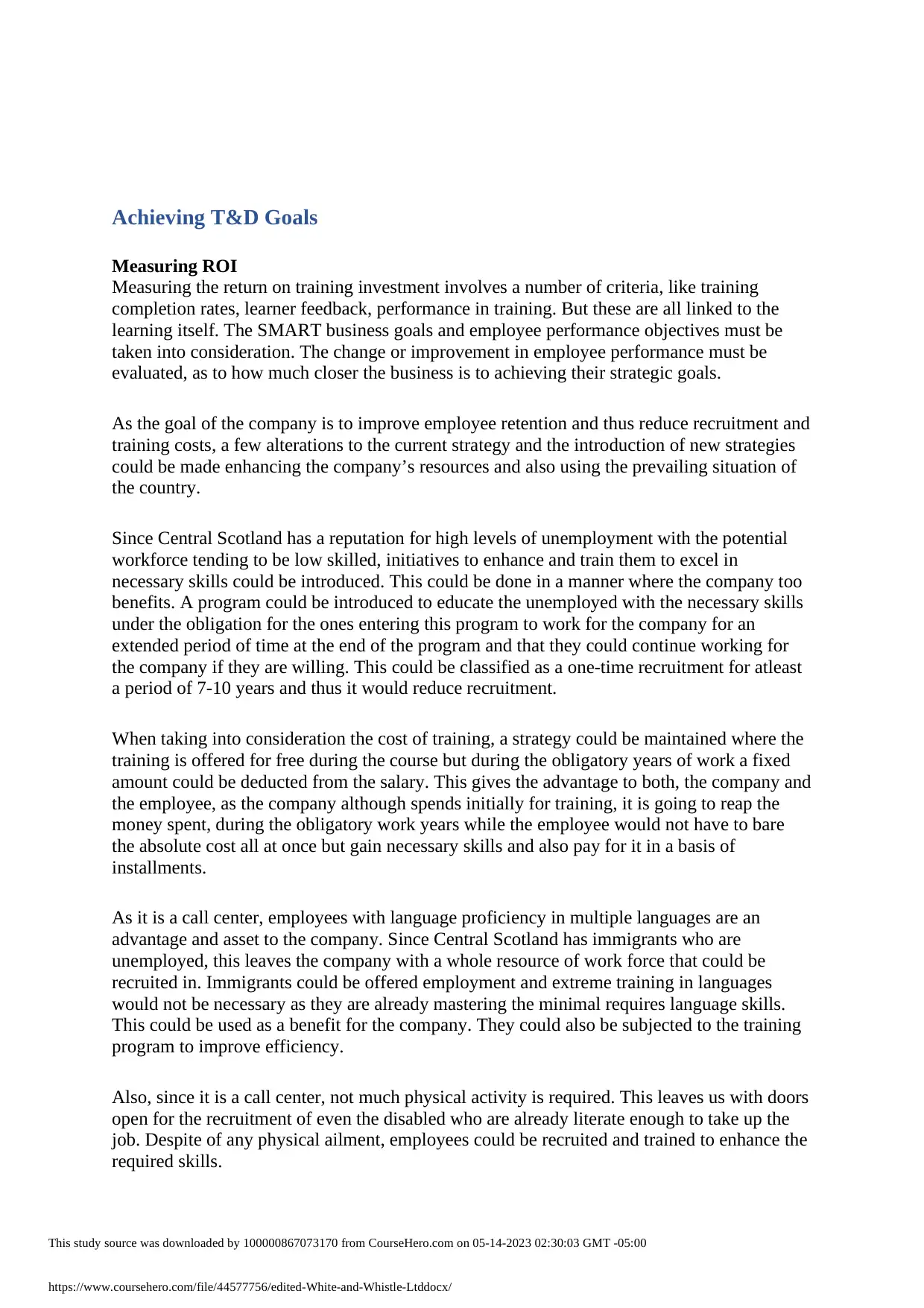
Achieving T&D Goals
Measuring ROI
Measuring the return on training investment involves a number of criteria, like training
completion rates, learner feedback, performance in training. But these are all linked to the
learning itself. The SMART business goals and employee performance objectives must be
taken into consideration. The change or improvement in employee performance must be
evaluated, as to how much closer the business is to achieving their strategic goals.
As the goal of the company is to improve employee retention and thus reduce recruitment and
training costs, a few alterations to the current strategy and the introduction of new strategies
could be made enhancing the company’s resources and also using the prevailing situation of
the country.
Since Central Scotland has a reputation for high levels of unemployment with the potential
workforce tending to be low skilled, initiatives to enhance and train them to excel in
necessary skills could be introduced. This could be done in a manner where the company too
benefits. A program could be introduced to educate the unemployed with the necessary skills
under the obligation for the ones entering this program to work for the company for an
extended period of time at the end of the program and that they could continue working for
the company if they are willing. This could be classified as a one-time recruitment for atleast
a period of 7-10 years and thus it would reduce recruitment.
When taking into consideration the cost of training, a strategy could be maintained where the
training is offered for free during the course but during the obligatory years of work a fixed
amount could be deducted from the salary. This gives the advantage to both, the company and
the employee, as the company although spends initially for training, it is going to reap the
money spent, during the obligatory work years while the employee would not have to bare
the absolute cost all at once but gain necessary skills and also pay for it in a basis of
installments.
As it is a call center, employees with language proficiency in multiple languages are an
advantage and asset to the company. Since Central Scotland has immigrants who are
unemployed, this leaves the company with a whole resource of work force that could be
recruited in. Immigrants could be offered employment and extreme training in languages
would not be necessary as they are already mastering the minimal requires language skills.
This could be used as a benefit for the company. They could also be subjected to the training
program to improve efficiency.
Also, since it is a call center, not much physical activity is required. This leaves us with doors
open for the recruitment of even the disabled who are already literate enough to take up the
job. Despite of any physical ailment, employees could be recruited and trained to enhance the
required skills.
This study source was downloaded by 100000867073170 from CourseHero.com on 05-14-2023 02:30:03 GMT -05:00
https://www.coursehero.com/file/44577756/edited-White-and-Whistle-Ltddocx/
Measuring ROI
Measuring the return on training investment involves a number of criteria, like training
completion rates, learner feedback, performance in training. But these are all linked to the
learning itself. The SMART business goals and employee performance objectives must be
taken into consideration. The change or improvement in employee performance must be
evaluated, as to how much closer the business is to achieving their strategic goals.
As the goal of the company is to improve employee retention and thus reduce recruitment and
training costs, a few alterations to the current strategy and the introduction of new strategies
could be made enhancing the company’s resources and also using the prevailing situation of
the country.
Since Central Scotland has a reputation for high levels of unemployment with the potential
workforce tending to be low skilled, initiatives to enhance and train them to excel in
necessary skills could be introduced. This could be done in a manner where the company too
benefits. A program could be introduced to educate the unemployed with the necessary skills
under the obligation for the ones entering this program to work for the company for an
extended period of time at the end of the program and that they could continue working for
the company if they are willing. This could be classified as a one-time recruitment for atleast
a period of 7-10 years and thus it would reduce recruitment.
When taking into consideration the cost of training, a strategy could be maintained where the
training is offered for free during the course but during the obligatory years of work a fixed
amount could be deducted from the salary. This gives the advantage to both, the company and
the employee, as the company although spends initially for training, it is going to reap the
money spent, during the obligatory work years while the employee would not have to bare
the absolute cost all at once but gain necessary skills and also pay for it in a basis of
installments.
As it is a call center, employees with language proficiency in multiple languages are an
advantage and asset to the company. Since Central Scotland has immigrants who are
unemployed, this leaves the company with a whole resource of work force that could be
recruited in. Immigrants could be offered employment and extreme training in languages
would not be necessary as they are already mastering the minimal requires language skills.
This could be used as a benefit for the company. They could also be subjected to the training
program to improve efficiency.
Also, since it is a call center, not much physical activity is required. This leaves us with doors
open for the recruitment of even the disabled who are already literate enough to take up the
job. Despite of any physical ailment, employees could be recruited and trained to enhance the
required skills.
This study source was downloaded by 100000867073170 from CourseHero.com on 05-14-2023 02:30:03 GMT -05:00
https://www.coursehero.com/file/44577756/edited-White-and-Whistle-Ltddocx/
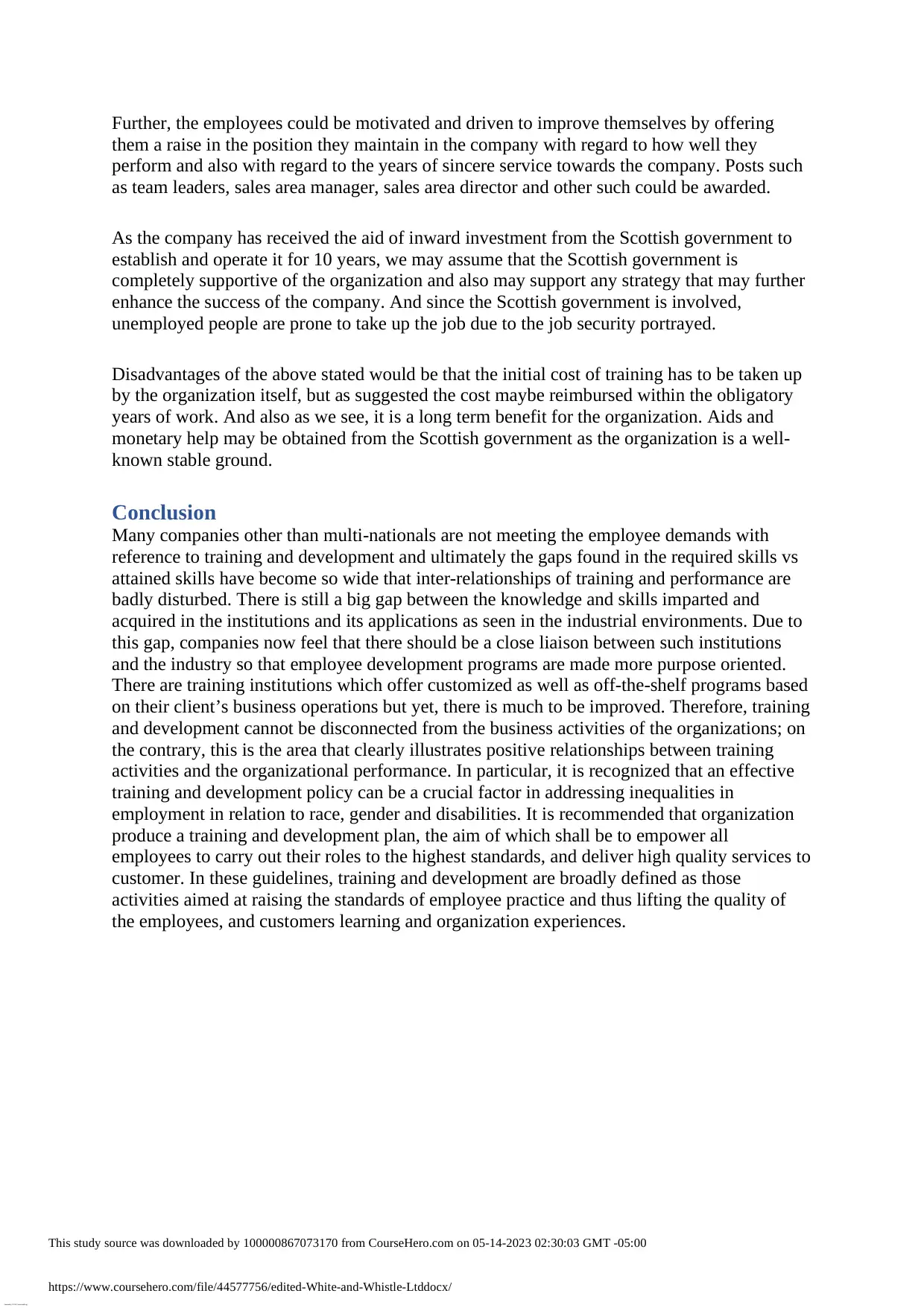
Further, the employees could be motivated and driven to improve themselves by offering
them a raise in the position they maintain in the company with regard to how well they
perform and also with regard to the years of sincere service towards the company. Posts such
as team leaders, sales area manager, sales area director and other such could be awarded.
As the company has received the aid of inward investment from the Scottish government to
establish and operate it for 10 years, we may assume that the Scottish government is
completely supportive of the organization and also may support any strategy that may further
enhance the success of the company. And since the Scottish government is involved,
unemployed people are prone to take up the job due to the job security portrayed.
Disadvantages of the above stated would be that the initial cost of training has to be taken up
by the organization itself, but as suggested the cost maybe reimbursed within the obligatory
years of work. And also as we see, it is a long term benefit for the organization. Aids and
monetary help may be obtained from the Scottish government as the organization is a well-
known stable ground.
Conclusion
Many companies other than multi-nationals are not meeting the employee demands with
reference to training and development and ultimately the gaps found in the required skills vs
attained skills have become so wide that inter-relationships of training and performance are
badly disturbed. There is still a big gap between the knowledge and skills imparted and
acquired in the institutions and its applications as seen in the industrial environments. Due to
this gap, companies now feel that there should be a close liaison between such institutions
and the industry so that employee development programs are made more purpose oriented.
There are training institutions which offer customized as well as off-the-shelf programs based
on their client’s business operations but yet, there is much to be improved. Therefore, training
and development cannot be disconnected from the business activities of the organizations; on
the contrary, this is the area that clearly illustrates positive relationships between training
activities and the organizational performance. In particular, it is recognized that an effective
training and development policy can be a crucial factor in addressing inequalities in
employment in relation to race, gender and disabilities. It is recommended that organization
produce a training and development plan, the aim of which shall be to empower all
employees to carry out their roles to the highest standards, and deliver high quality services to
customer. In these guidelines, training and development are broadly defined as those
activities aimed at raising the standards of employee practice and thus lifting the quality of
the employees, and customers learning and organization experiences.
This study source was downloaded by 100000867073170 from CourseHero.com on 05-14-2023 02:30:03 GMT -05:00
https://www.coursehero.com/file/44577756/edited-White-and-Whistle-Ltddocx/
Powered by TCPDF (www.tcpdf.org)
them a raise in the position they maintain in the company with regard to how well they
perform and also with regard to the years of sincere service towards the company. Posts such
as team leaders, sales area manager, sales area director and other such could be awarded.
As the company has received the aid of inward investment from the Scottish government to
establish and operate it for 10 years, we may assume that the Scottish government is
completely supportive of the organization and also may support any strategy that may further
enhance the success of the company. And since the Scottish government is involved,
unemployed people are prone to take up the job due to the job security portrayed.
Disadvantages of the above stated would be that the initial cost of training has to be taken up
by the organization itself, but as suggested the cost maybe reimbursed within the obligatory
years of work. And also as we see, it is a long term benefit for the organization. Aids and
monetary help may be obtained from the Scottish government as the organization is a well-
known stable ground.
Conclusion
Many companies other than multi-nationals are not meeting the employee demands with
reference to training and development and ultimately the gaps found in the required skills vs
attained skills have become so wide that inter-relationships of training and performance are
badly disturbed. There is still a big gap between the knowledge and skills imparted and
acquired in the institutions and its applications as seen in the industrial environments. Due to
this gap, companies now feel that there should be a close liaison between such institutions
and the industry so that employee development programs are made more purpose oriented.
There are training institutions which offer customized as well as off-the-shelf programs based
on their client’s business operations but yet, there is much to be improved. Therefore, training
and development cannot be disconnected from the business activities of the organizations; on
the contrary, this is the area that clearly illustrates positive relationships between training
activities and the organizational performance. In particular, it is recognized that an effective
training and development policy can be a crucial factor in addressing inequalities in
employment in relation to race, gender and disabilities. It is recommended that organization
produce a training and development plan, the aim of which shall be to empower all
employees to carry out their roles to the highest standards, and deliver high quality services to
customer. In these guidelines, training and development are broadly defined as those
activities aimed at raising the standards of employee practice and thus lifting the quality of
the employees, and customers learning and organization experiences.
This study source was downloaded by 100000867073170 from CourseHero.com on 05-14-2023 02:30:03 GMT -05:00
https://www.coursehero.com/file/44577756/edited-White-and-Whistle-Ltddocx/
Powered by TCPDF (www.tcpdf.org)
⊘ This is a preview!⊘
Do you want full access?
Subscribe today to unlock all pages.

Trusted by 1+ million students worldwide
1 out of 9
Related Documents
Your All-in-One AI-Powered Toolkit for Academic Success.
+13062052269
info@desklib.com
Available 24*7 on WhatsApp / Email
![[object Object]](/_next/static/media/star-bottom.7253800d.svg)
Unlock your academic potential
Copyright © 2020–2025 A2Z Services. All Rights Reserved. Developed and managed by ZUCOL.





